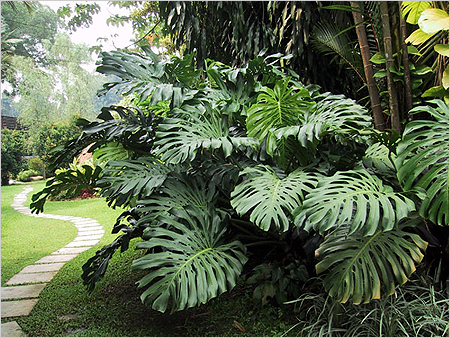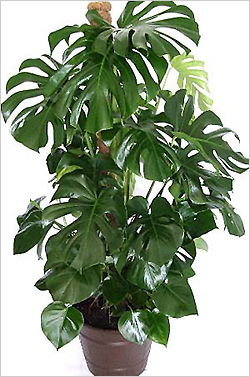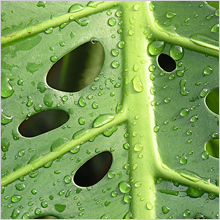Monstera Care
Monstera is a perennial tropical vine of the arum family. The homeland of Monstera is the humid tropical forests of Brazil and Guatemala. There are about 30 species of Monstera known in nature.

The large glossy leaves of Monstera can reach a diameter of one meter in some species. In greenhouses and winter gardens, Monstera can grow up to 20 meters in length.

In apartments and offices, its dimensions are usually much smaller. Stems with aerial roots can grow up to 6 meters in length and eventually become woody. The growth point of Monstera is located at the top of the stem. It is better not to trim the aerial roots of Monstera but to tie them to the stem or let them into the soil. Trimming the aerial roots negatively affects the plant.
Young leaf plates are initially entire, heart-shaped, and become lobed or perforated with age.
In indoor conditions, Monstera leaves typically have a length of about 30 cm on average but can be much larger.
As Monstera is a vine, it needs support. It is usually given a vertical shape using various supports: artificial stems, decorative ladders.
In overcast weather, especially in humid apartments, Monstera leaves release large water droplets. By observing Monstera behavior, one can predict the onset of rainy weather within a day.
Snow-white flowers of Monstera rarely appear in home conditions.

In indoor floriculture, Monstera deliciosa and its varieties are widespread. There is a variegated variety (Monstera variegata) with white or cream spots on the leaves.
Monstera deliciosa borsigiana is smaller in size and can be grown in small spaces.
Monstera obliqua is distinguished by asymmetric leaves.


Caring for Monstera at Home
The peculiarity of caring for Monstera is that it is a fairly large indoor plant and, therefore, requires space. Monstera cannot be grown in a corner by the window; it will quickly outgrow and require a considerable amount of space in your apartment.
Light: Monstera should be grown in well-lit places but not under direct sunlight. The huge leaves need light, but diffused sunlight suits them. Monstera tolerates a lack of light well, but its growth slows down. It should not be placed in drafts, and this indoor plant does not tolerate frequent turns and movements. Powerful stems of Monstera with heavy large leaves need support.
Temperature: Monstera likes average room temps (65-75°F/18-24°C). In warm rooms, the plant grows faster, and the leaves become larger and more patterned. It does not like cold air in winter.
Watering: Watering should be regular, but Monstera can tolerate uneven moisture. Overwatering leads to leaf loss, and the plant may exhibit the "crying leaves" syndrome.
Humidity: The indoor vine of Monstera tolerates dry air well, but it needs to be periodically sprayed, cleaned from dust, and dirt.
Soil: Regular soil for aroids is suitable.
Fertilization: During the warm period, when Monstera grows intensively, it needs to be fertilized twice a month.
Repoting: Young Monsteras grow more intensively, and they are transplanted every year in spring. 3-4-year-olds are transplanted every 2 years, and older ones every 3-4 years, but fresh soil should be added on top. Choose pots with a large diameter. If the plant is already large, it is advisable to install a new sturdy support during transplantation.
Support: It is best to use an artificial stem: when planting, a stem is installed next to the stem in the center of the pot (you can buy it in a flower shop or make it yourself) with a height of 70-100 cm. It is wrapped with sphagnum, fixing the moss with synthetic twine or wire. The moss is kept constantly moist, moistening it with a solution of nutrients. In this case, the aerial roots that do not reach the ground receive additional moisture and nutrients, reaching the soil surface more quickly. At the same time, this stem serves as good support for the plant.
Propagation: Propagating Monstera is not difficult. Like all aroids, this tropical vine is best propagated by apical cuttings and cuttings from the middle of the stem. Each cutting must have a bud. Cuttings are rooted in water, sphagnum moss, or sand. To improve rooting and accelerate growth, cover the cutting with a glass jar or plastic wrap, securing it with wire from both sides. Keep cuttings warm (around 70°F/21°C) and in indirect sunlight or artificial light. Rooting takes 25-30 days.
It is even easier to propagate Monstera with aerial offshoots of the shoots. For this, the stem is wrapped with moist sphagnum and then wrapped with plastic wrap, securing it with wire from both sides. After roots appear, this section of the stem is separated from the mother plant and planted in a separate pot.
Diseases and Pests: Monstera is damaged by scale insects and spider mites. There may be a powdery coating on the leaves, indicating that the plant is affected by mealybugs.




